As time goes by, and cost of materials continues to rise, cheap parts make their way into almost everything. Guns, of course, are no exception to the rule when it comes to manufacturing cost reduction. The manufacturers’ savings show up as those misplaced components you notice the first time you pick up a new rifle – not misplaced enough to make you pass on the opportunity to purchase, but enough to take away from the gun’s overall appearance, and your appreciation for the gun.
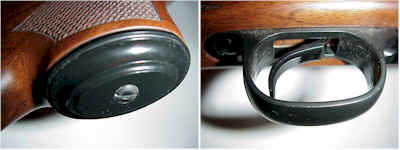
This is probably a good example. These are factory parts from a new Model 70 Winchester. The pistol grip cap is made of soft glossy plastic which, in this case, doesn’t even fit to the wood very well. The trigger guard is thick cast aluminum, with an oversized trigger slot making lots of room for gunk to get in, and a finish that looks like Sherwin & Williams best exterior house paint.
Fortunately, the firearms industry is filled with lots of enterprising folks. Just like the endless stream of better than factory 1911 auto parts, there are lots of improved replacement parts for virtually every handgun and long gun. Companies such as: Williams Mfg., Sunny Hill, Brownells, Heritage Arms, Harris Gunworks, Dakota, Jerry Fisher and McFarland all produce upgrade replacement and custom grade hardware. The greatest selection seems to be in trigger guard / floor plate assemblies, skeleton butt plates, grip caps, barrel bands, and flush fitting swivel studs.
Grip Caps
Grips are available “in the white”, with a variety of finishes, skeleton cut, raised flat for engraving, English style…. Some are made for custom installation and require a competent woodworker to inlet and fit, but most are made within a range of three standard dimensions suitable for almost anyone to install, except for my ex brother-in-law, but that’s a whole other story.
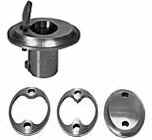 The three caps, lower left, are made by Dakota Arms. The top cap is an N.E.C.G. Trap Door. The skeleton caps need to be precisely inlayed around the the grip so the wood rises to fill the center. The flat is perfect for engraving, is extra thick and requires edge inlaying. They are all bare metal and require final finish.
The three caps, lower left, are made by Dakota Arms. The top cap is an N.E.C.G. Trap Door. The skeleton caps need to be precisely inlayed around the the grip so the wood rises to fill the center. The flat is perfect for engraving, is extra thick and requires edge inlaying. They are all bare metal and require final finish.
The trap door model is great for emergency use, and permit the owner to store food or shelter in the recess. I can only assume the trap door fills our adolescent need to have a place to hide stuff. These are also shipped in the white. Sizes are typically: large 1.8″ x 1.4, medium 1.75″ x 1.3″ 1.7″ x 1.2″. There is a lot of overlap in styles from manufacturers, and sizes vary by approximately .010″, so you can select to get to a specific size, or assume you can adjustments to cap and stock during fitting.
 Several more cap designs: flat for engraved or polished plain, 2 screws to allow unbroken monogram engraving, English classic style for that favorite double rifle, shotgun or maybe a gun from the rash of recently introduced express rifles. They are all in white, all in a variety of sizes and all excellent parts, putting real metal back in firearms. Most are quality investment castings, some are machined from billet, all are priced accordingly. I took the coward’s route.
Several more cap designs: flat for engraved or polished plain, 2 screws to allow unbroken monogram engraving, English classic style for that favorite double rifle, shotgun or maybe a gun from the rash of recently introduced express rifles. They are all in white, all in a variety of sizes and all excellent parts, putting real metal back in firearms. Most are quality investment castings, some are machined from billet, all are priced accordingly. I took the coward’s route.
I didn’t want to start whittling on my gun stock, I didn’t want to spot blue or cold blue a part, nor did I want to walk into a gunsmith and ask him to send out a silver dollar sized component for bluing. I did want a flat finished cap that would blend in with the Winchester Classic satin finish stock. I picked a Neidner traditional style cap, flat blackened finish, cast-in checkering with a single center screw. The cap measured 1 13/16″ x 1 5/16″ and fit the stock pistol grip perfectly, without modification.
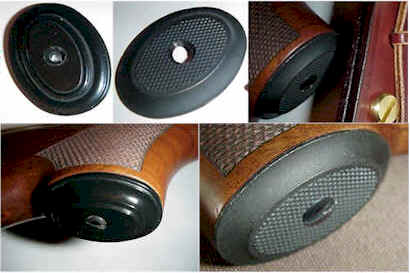 The original plastic cap on the left was pretty cheezoid. I can only describe the new cap as hefty, like a cast iron stove, and the fit is excellent. I think the flat finished fits the non-gloss stock and leather/brass hardware. The cap cost $17 and took maybe 5 minutes to swap, 3 spent looking for a screwdriver. The Brownells stock number is #078-010-110. You’ll find all the other caps there also.
The original plastic cap on the left was pretty cheezoid. I can only describe the new cap as hefty, like a cast iron stove, and the fit is excellent. I think the flat finished fits the non-gloss stock and leather/brass hardware. The cap cost $17 and took maybe 5 minutes to swap, 3 spent looking for a screwdriver. The Brownells stock number is #078-010-110. You’ll find all the other caps there also.
Trigger Guards and floor plate assemblies
I think what surprised me most about these parts is the spread in prices. They range running from inexpensive to “If I’m paying 10 grand for the rifle, what’s a few hundred more for a trigger guard”. The trigger guard I personally chose was….well, cost effective. To be fair, some provide more than improved appearance and most designs are available for Mauser, Remington and Winchester barreled actions and rifles.

Left to right – The H.S. Precision coverts a Remington 700 to a detachable mag configuration for about $185.00. $400 will deliver a custom Pete Grisel guard/mag/floor plate assembly for that special anything from a Mauser to a Weatherby. $95 buys a Brownells conversion from a Remington blind magazine ADL to a hinged floorplate BDL. At less than $40, Williams Mfg. sells steel machined guards to replace molded plastic and cast aluminum factory parts. Some come in white only, mostly the expensive assemblies, while the others can typically be ordered in stainless, or white, bead and polished blue chrome moly steel.
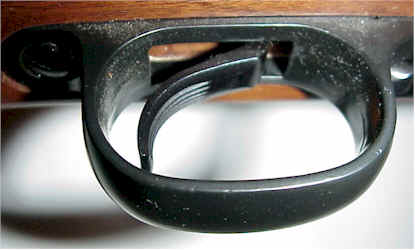 Okay, I apologize for the giant graphic, but it is important to recognize the enemy. There are a lot of clues. The part is painted and will stop looking gloss black and start looking blob gray after a couple of weeks.
Okay, I apologize for the giant graphic, but it is important to recognize the enemy. There are a lot of clues. The part is painted and will stop looking gloss black and start looking blob gray after a couple of weeks.
The paint will chip and wrinkle just from moving the gun in and out of a soft case. The “one size fits all” trigger opening is huge. Who knows, you could get a trigger finger or an ear stuck in there, and causing you to have the errant appendage amputated. A small pointed stick could get in there just as you’re ready to shoot a record elk. Hey, it could happen.
Yes, these cast aluminum parts are light, but not the “good” kind of light. This guard is nothing like the ultra light weight aluminum parts that are currently on sale for the ultra light weight rifle guys – Those are technically called weight saving devices, and carry a premium hundreds of dollars price tag. These factory parts cost about $10.
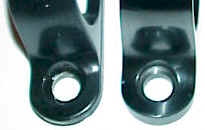 This is a good example of the difference between a cheap castings without machining, and a decent piece of steel that has been cut, polished and properly blued. The aluminum part of the left if already losing its coating around the screw holes. The edges are are heavily rounded, and you won’t find a precisely defined radius or shoulder. There is no traditional polishing grain on the surface, and the coating really is some type of epoxy based paint prone to chipping, wrinkles and fading.
This is a good example of the difference between a cheap castings without machining, and a decent piece of steel that has been cut, polished and properly blued. The aluminum part of the left if already losing its coating around the screw holes. The edges are are heavily rounded, and you won’t find a precisely defined radius or shoulder. There is no traditional polishing grain on the surface, and the coating really is some type of epoxy based paint prone to chipping, wrinkles and fading.
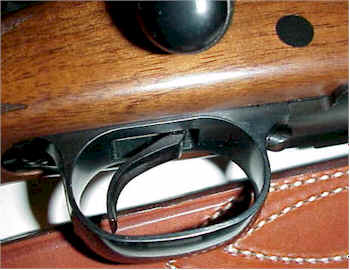 You can see the large gaps between the guard and the wood, as well as the terrible gap between the floor plate and the leading edge of the guard. Oh, that’s right, there are no gaps – in fact a perfect fit. I’d like to take credit for some quality craft work, but in reality, these are good fitting parts that just drop right into place. Both metal and wood fit is better than the factory parts. The finish and color matches the barrel and receiver. This Williams’ guard carries Brownells stock number #954-100-000 starting at $30. You will find a full selection of similar parts at the same location.
You can see the large gaps between the guard and the wood, as well as the terrible gap between the floor plate and the leading edge of the guard. Oh, that’s right, there are no gaps – in fact a perfect fit. I’d like to take credit for some quality craft work, but in reality, these are good fitting parts that just drop right into place. Both metal and wood fit is better than the factory parts. The finish and color matches the barrel and receiver. This Williams’ guard carries Brownells stock number #954-100-000 starting at $30. You will find a full selection of similar parts at the same location.
It’s sort of odd that on one hand, firearm manufacturers are busy removing all remnants of quality, after determining people will not pay to cover the escalating cost of materials, labor and overhead. But if that’s so, how did we end up with such a growth industry in companies specializing in making premium quality replacement parts, designed to fill in for all of the factory deficiencies ? I suppose that’s positive. We have more volume producing gun companies in existence today then we had 20 years ago.
More “Looking for a great small gun”
Looking for a great small gun
Looking for a great small gun II
Winchester Model 70 Scope selection / installation
A gripping story to catch you off guard
Thanks,
Joe

Email Notification